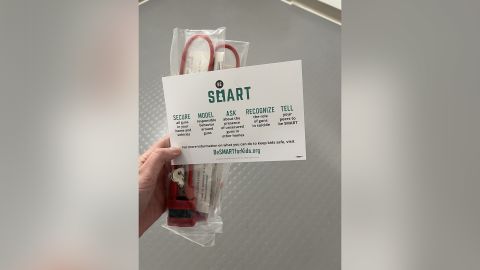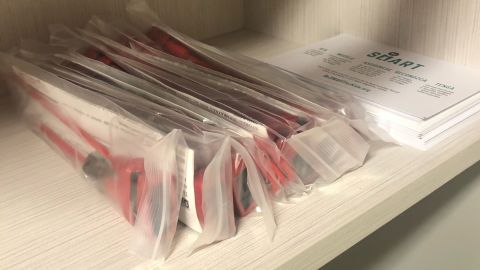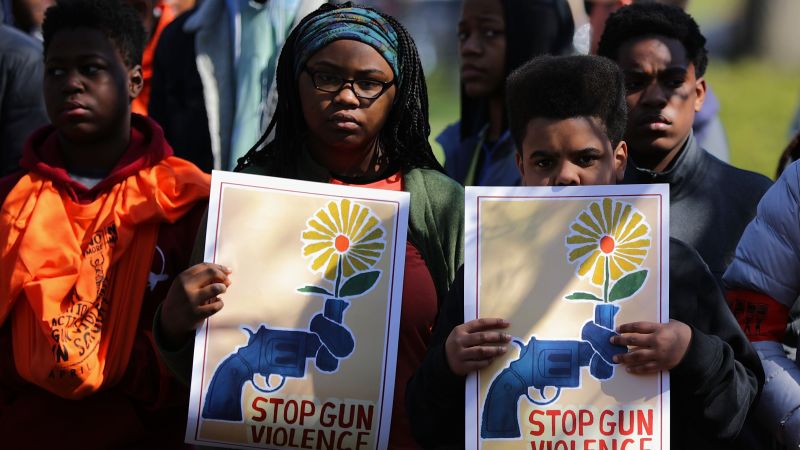CNN
—
In a triage waiting room of St. Louis Children’s Hospital in Missouri, a clear basket filled with gun locks sits near the walkway, just noticeable enough to those passing by.
The hospital staff calls it the “No Questions Asked” basket, to encourage gun safety without having to confront gun owners about what can be a sensitive and divisive topic. It holds an assortment of cable gun locks free of charge, available to those who need them, alongside pamphlets explaining how to properly and safely store firearms.
The initiative, aimed at reducing the stigma of addressing gun safety, is part of a growing effort by medical professionals who are treating the country’s gun violence epidemic as a public health crisis.
“It takes standing at the bedside of one child who has been shot to realize that we all have to do more and as the leading cause of death for children in this country, pediatricians need to be front and center of the solution, of all the solutions,” said Dr. Annie Andrews, a professor of pediatrics at the Medical University of South Carolina and an expert on gun violence prevention.
Over the course of two years, thousands of gun locks have been taken from the basket, according to Dr. Lindsay Clukies, a pediatric emergency medicine physician at the hospital.
In the coming weeks, baskets filled with free gun locks will be available at more than 17 locations operated by BJC HealthCare, an organization serving metro St. Louis, mid-Missouri and Southern Illinois, Clukies said. It’s a low-cost and effective way to easily distribute firearm safety devices.
“We’ve had employees as well as patients take our locks, also their families and even a grandmother who took one for her grandson. It’s for anyone who needs them,” Clukies told CNN. In recent years, a rising number of pediatricians across the country have been engaging with the topic of gun safety in medical settings by focusing on safety and prevention, already a natural aspect of their work.
During patient visits, it’s increasingly common for pediatricians to ask the patient’s parents if there are guns at home, and if so, how they are stored. Some hospitals then offer free gun locks, often sourced from donations or police departments and paired with safe storage education.

Some pediatricians, who bear witness to the effects of gun violence on children in their workplace every day, told CNN they see it as their obligation as medical professionals to be part of the solution to the epidemic.
In 2022, 1,672 children and teenagers under 17 were killed by gun violence and 4,476 were injured, according to the Gun Violence Archive, a nonprofit organization tracking injuries and deaths by gunfire since 2014.
“We have just as an important voice in this conversation as anyone else because we’re the ones who have invested our entire careers to protecting children and ensuring that children can grow up to be the safest healthiest version of themselves,” said Andrews.
“It is only natural that we see these things that we understand that they’re preventable, and we want to get involved in finding the solutions,” she added.
So far in 2023, high-profile incidents of children accessing firearms have heeded calls for stronger, more consistent laws nationwide, requiring adults to safely secure their guns out of the reach of children and others unauthorized to use them. They have also highlighted a lack of public education on the responsibility of gun owners to store their guns unloaded, locked and away from ammunition, CNN previously reported.
In early January, a 6-year-old boy was taken into police custody after he took a gun purchased by his mother from his home, brought it to school and shot his teacher at Richneck Elementary School in Newport News, Virginia, police said. Just over a week later, a man was arrested in Beech Grove, Indiana, after video was shown on live TV of a toddler, reportedly the man’s son, waving and pulling the trigger of a handgun, CNN previously reported.
Hundreds of children in the US every year gain access to firearms and unintentionally shoot themselves or someone else, according to research by Everytown for Gun Safety, a leading non-profit organization focusing on gun violence prevention. In 2022, there were 301 unintentional shootings by children, resulting in 133 deaths and 180 injuries nationally, Everytown data showed.
Firearm injuries are now the leading cause of death among people younger than 24 in the United States, according to the Centers for Disease Control and Prevention. The American Academy of Pediatrics released an updated policy statement in October 2022, stating firearms are now the leading cause of death in children under the age of 24 in the US.
The Academy’s statement urged a “multipronged approach with layers of protection focused on harm reduction, which has been successful in decreasing motor vehicle-related injuries, is essential to decrease firearm injuries and deaths in children and youth.”
The Academy has free educational modules for pediatricians to guide them on how to have what can be challenging or uncomfortable conversations about firearms with families, according to Dr. Lois Kaye Lee, a pediatrician and the chair of the Academy’s Council on Injury, Violence and Poison Prevention.
“This shouldn’t be considered as something extra; it should be considered as part of the work that we do every day around injury prevention, be it around firearms, child passenger safety and suicide prevention,” Lee said.
Dr. Georges Benjamin, executive director of the American Public Health Association, told CNN the public health approach to addressing gun violence removes the politics from the issue and “puts it into a scientific evidence-based framework.”
“Physicians have a unique opportunity to engage their patients, the parents of kids or the parents themselves as individuals to make their homes safer,” Benjamin said. “We already do this for toxins under our kitchen cabinets, razor blades and outlets in the wall.”
In the emergency department at St. Louis Children’s Hospital, all patients are screened for access to firearms and offered free gun locks, as well as safe storage education, Clukies said. Gun locks can also be mailed to families, free of cost, through the hospital’s website.
“Every patient that comes into our emergency department, whether it’s for a fever or a cold or a broken arm, is asked about access to firearms,” said Clukies, adding 5,000 locks have been given out since the initiatives were started in 2021.
In a collaborative effort between trauma nurses, physicians, social workers, violence intervention experts and family partners, the hospital created a “nonjudgmental” script for doctors to follow as they ask patients about access to firearms, Clukies said.
During the screening process, pediatricians will ask parents or caretakers questions such as: Do you have access to a firearm where your child lives or plays? How is it stored? Is it stored unloaded or loaded?
“When I first started doing this, I would say, ‘Are there any guns in the home? Yes, or no?’ But I have found and learned from other experts that if you just say, ‘If there are any guns in the home, do you mind telling me how they’re secured?’ it takes away the judgment,” said Andrews, a pediatrician whose hospital, the Medical University of South Carolina, also offers free gun locks to patients.

Families are asked about firearms in the “social history” phase of a patient visit, during which pediatricians will ask who lives in the home, what grade the child is in, what activities they engage in and where the child goes to school, according to Andrews. When parents indicate their firearms are not safely stored, like on the top of a shelf or in a nightstand drawer, Andrews said those are important opportunities for intervention and education about storage devices such as keypad lockboxes, fingerprint biometric safes and other types of lock systems.
It’s also important for pediatricians to understand the parents’ or caretakers’ motivation for owning a firearm to “inform the conversation about where they’re willing to meet you as far as storage goes,” she added.
Andrews and Clukies said they were pleasantly surprised by the willingness of families to discuss firearm safety, most of whom recognize it is an effort to protect their children.
“I expected more pushback than we received, which is attributed to us really focusing on how we properly word these questions,” Clukies said. “I think it’s because we turn it into a neutral conversation, and we focus on safety and prevention.”
Andrews added it is uncommon for medical schools or residencies to discuss gun violence prevention, which she says is due to the “politics around the issue.”
“Thankfully, that has evolved, and more and more pediatricians are realizing that we have to be an integral part of the solution to this problem,” Andrews said.
At the St. Louis Children’s Hospital, pediatricians followed up with patients who received a free gun lock in a research study roughly two months after they launched the initiative in the fall of 2021 to see if their storage practices changed.
The study found two-thirds of families reported using the gun lock provided to them by the hospital and there was a “statistically significant decrease” in those who didn’t store their firearms safely, as well as an increase in those who stored their firearms unloaded, according to Clukies.
But there is still much more work to be done in the medical community to fight the gun violence epidemic and scientific research on the issue is “woefully underfunded,” Andrews contended.
According to the American Public Health Association’s Benjamin, a multidisciplinary approach by policymakers, law enforcement and the medical community is essential to fostering a safer environment for children.
“Injury prevention is a core part of every physician’s job,” Benjamin said. “It’s clearly in our lane.”

